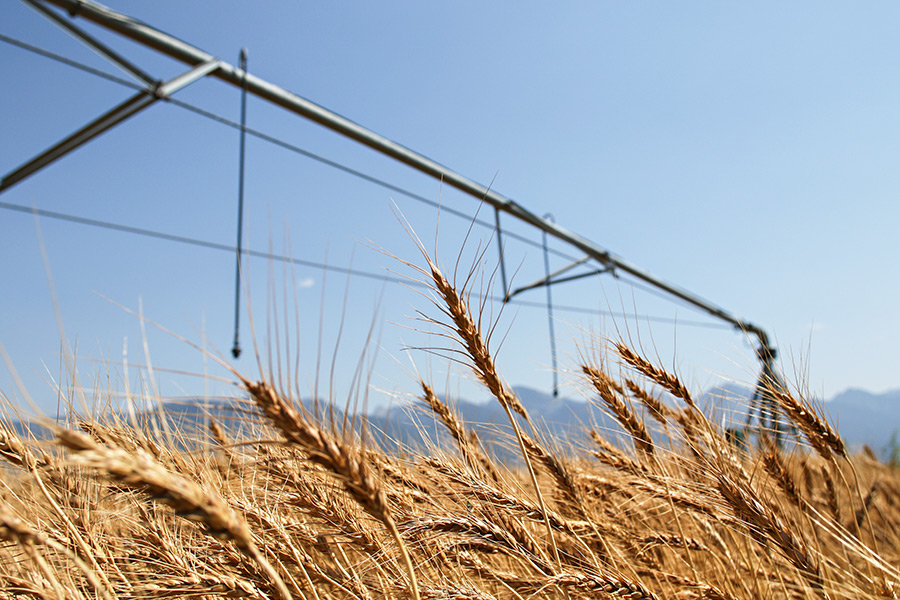The summer of 2015, with its smoke-filled skies from roiling wildfires and dry heat, was the driest on record in Kalispell. River streamflows were the lowest on record for late August, and dry-land farmers in the Flathead Valley were expecting a grain and hay crop of about 50 percent of normal levels.
It was a brutal season for agriculture in the valley; hay had to be trucked in for local livestock, and some farmers cut their struggling wheat crops early to sell as forage.
And if the climate continues in this pattern, with warmer temperatures and less precipitation in the summers, it could mean a loss of nearly 25,000 jobs in agriculture – including raising cattle – and $736 million in labor earnings by 2055, according to a report commissioned by the Montana Farmers Union.
The report, titled “The Impact of Climate Change on Montana’s Agrilcultural Economy,” was compiled by Thomas Michael Power and Donovan S. Power of Power Consulting Inc.
In it, the authors write that Montana’s temperature will increase by 4 to 5 degrees by 2055, with more precipitation hitting the state but during the winter months, and in the form of rain, not snow.
This means less snowpack and any runoff at all will come earlier in the spring.
“Disease and beetle kill will increase as the temperature increases and the summer moisture decreases and the native trees are too stressed to resist,” the reports reads. “The very composition of our forests will change causing the loss of the white bark pine and a transition from Ponderosa Pine and Douglas-fir to spruce-fir. The grasslands of Montana will convert to sagebrush and other scrub brush dominant species.”
Shorter, warmer, wetter winters could allow for an increased wheat harvest, but the researchers predict the higher temperatures and depletion of nitrogen in the soil – from the plants growing too fast in early spring – could decrease wheat yields regardless.
This future isn’t set in stone, but officials in Montana’s agricultural scene say that such concerns are behind their push for more diversified, drought-resistant crops throughout the state.
“I’m really pleased that [the Montana Farmers Union] did the report. I’m looking forward to more information,” Ron de Yong, director of the state Department of Agriculture, said in an interview last week. “Things are changing and we need to learn as much as we possibly can.”
De Yong said climate change concerns have been the focus of a collaboration between Montana State University and the University of Montana, leading to seminars with producers to understand which questions they need answered.
Chris Christiaens, legislative and project specialist for MFU, said there has been a push in the last 18 months to educate producers on the importance of diversifying their crops.
Farmers are also trying to get their crops in earlier to take advantage of wet weather in the early spring, but that leaves them open to frost damage. Christiaens said the winter wheat is already out of dormancy with the warm spring so far, but if it turns cold again, a snowstorm could smother the crop.
“There’s something certainly different,” Christiaens said. “So we’re saying if you want to stay in business, think about diversifying, think about crops that are more drought resistant.”
In the Flathead, a change in the climate might mean fewer dry-land farms or new crops in the fields, according to Patricia McGlynn, MSU extension agent. A strong American dollar as well as a glut of wheat on the international market are other economic challenges, she said.
A majority of valley farmers also face another headwind, McGlynn said, because 60 percent of the agricultural land in Flathead County is leased. That adds an extra level of financial pressure to farmers who have to pay a landlord and deal with drought conditions, she said.
McGlynn also said there are hundreds of models to predict climate change scenarios so this report isn’t the end-all, but it “may serve as a wake-up call to those who have been denying that climate change is happening.”
Christiaens said the effort to get industrial hemp into Montana’s fields holds potential; de Yong said research into the crop is moving forward through the federal Farm Bill. De Yong said Montana farmers should also look at more oil-seed crops.
Another potential solution would be agricultural carbon sequestration, meaning that farmers would leave the soil in tact and not release the carbon to the air instead of tilling the soil. A conservation stewardship program within the Farm Bill pays for such aspects, de Yong said, but otherwise there’s little incentive for farmers to work their fields this way.
“The market’s going to pay you the same amount for the bushels you produce. They don’t pay you for doing it right,” de Yong said. “In order to actually help the producers stay in business, we really should be incentivizing doing it right because the market’s not going to pay.”
The next Farm Bill is up in three years, he said, and this will likely be part of the conversation. If they want to stay in business, farmers are going to have to consider change, he said.
“Producers have an ability to adapt quite well,” de Yong said. “If we get more reports, more information to help the producers adapt, it won’t be as dire, but we’re going to have to be smart about this.”
